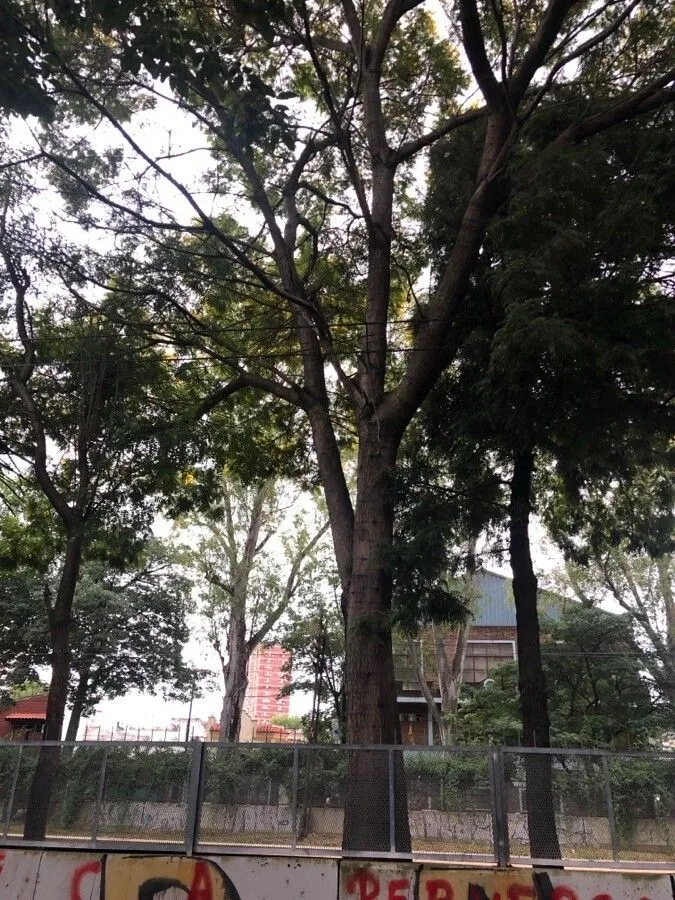
Author: (Spreng.) Taub.
Bibliography: H.G.A.Engler & K.A.E.Prantl, Nat. Pflanzenfam. 3(3): 176 (1892)
Year: 1892
Status: accepted
Rank: species
Genus: Peltophorum
Vegetable: False
Observations: Caribbean, S. Trop. America
The Horsebush, scientifically known as Peltophorum dubium, is a remarkable species of tree belonging to the Fabaceae family. Esteemed botanists H.G.A. Engler and K.A.E. Prantl first documented this species in the Nat. Pflanzenfam in 1892, bestowing upon it a significant place in botanical literature.
This splendid tree is indigenous to the warmer climates of the Caribbean and Southern Tropical America. It is renowned for its robust structure and the beauty it adds to the landscapes where it thrives. The horsebush features a broad canopy, providing ample shade with its expansive foliage. Its leaves are bipinnate, adding a fine-textured allure to the tree’s overall appearance.
One of the distinct characteristics of Peltophorum dubium is its striking yellow flowers. These blooms are not only visually appealing but also attract various pollinators, playing a crucial role in the ecosystem. The flowering season brings a burst of color to the regions this tree inhabits, marking a significant period for local flora and fauna.
The horsebush is well-adapted to the tropical climates, demonstrating a high level of resilience in its natural habitat. Its ability to thrive in such environments makes it a vital component of the local ecosystem, offering habitat and food for several wildlife species. Moreover, the tree is known for its utilitarian value; its wood is often utilized in construction and carpentry due to its durability and strength.
Overall, the horsebush (Peltophorum dubium) is a symbol of natural beauty and ecological importance in the Caribbean and Southern Tropical America. Its botanical significance is well-documented, and it continues to be a subject of interest for botanists and nature enthusiasts alike.
Eng: horsebush, copperpod
Por: canafista, canafístula, embirá, farinha-seca, faveira, guarucaia, imbira-puitá, pijuí, puitá, quebra-serra
En: Horsebush, Copperpod
Pt: Canafista, Canafístula, Embirá, Farinha-seca, Faveira, Guarucaia, Imbira-puitá, Pijuí, Puitá, Quebra-serra, Canafistula
© copyright of the Board of Trustees of the Royal Botanic Gardens, Kew.
© copyright of the Board of Trustees of the Royal Botanic Gardens, Kew.
© copyright of the Board of Trustees of the Royal Botanic Gardens, Kew.
Taken Dec 23, 2020 by Makoto Makoto (cc-by-sa)
Taken Feb 2, 2020 by vic (cc-by-sa)
Taken Dec 6, 2021 by Thiago Flores Flores (cc-by-sa)
Taken Dec 6, 2021 by Thiago Flores Flores (cc-by-sa)
Taken Jan 12, 2021 by Brunelli Júlio César (cc-by-sa)
Taken Nov 17, 2021 by Henrique Quadros (cc-by-sa)
Taken Dec 14, 2021 by Francisco Victor (cc-by-sa)
Taken Jan 5, 2022 by Arruda Aline (cc-by-sa)
Taken Dec 6, 2021 by Thiago Flores Flores (cc-by-sa)
Taken Dec 6, 2021 by Thiago Flores Flores (cc-by-sa)
Taken Jul 5, 2021 by Jonathan Golan (cc-by-sa)
Taken Jul 5, 2021 by Jonathan Golan (cc-by-sa)
Taken Apr 30, 2021 by Marques Lucas (cc-by-sa)
Taken Feb 5, 2020 by Garcia Marina (cc-by-sa)
Taken Jan 18, 2022 by Rodrigo Pampin (cc-by-sa)
Taken Aug 23, 2022 by Makoto Makoto (cc-by-sa)
Taken Jul 3, 2022 by ODwyer patricio (cc-by-sa)
Taken Aug 24, 2021 by Leandro da silva pereira (cc-by-sa)
Taken Jul 5, 2021 by Jonathan Golan (cc-by-sa)
Taken Apr 12, 2022 by gonzalo arthuro mendez maturrano (cc-by-sa)
Taken Jul 5, 2021 by Jonathan Golan (cc-by-sa)
Taken Dec 5, 2021 by Thiago Flores Flores (cc-by-sa)
Taken Jan 18, 2022 by Rodrigo Pampin (cc-by-sa)
Taken Dec 9, 2019 by Giuseppetti Fernando (cc-by-sa)
Family: Myrtaceae Author: (F.Muell.) K.D.Hill & L.A.S.Johnson Bibliography: Telopea 6: 402 (1995) Year: 1995 Status:…
Family: Rubiaceae Author: Pierre ex A.Froehner Bibliography: Notizbl. Bot. Gart. Berlin-Dahlem 1: 237 (1897) Year:…
Family: Sapindaceae Author: Koidz. Bibliography: J. Coll. Sci. Imp. Univ. Tokyo 32(1): 38 (1911) Year:…
Family: Asteraceae Author: A.Gray Bibliography: Pacif. Railr. Rep.: 107 (1857) Year: 1857 Status: accepted Rank:…
Family: Fabaceae Author: Medik. Bibliography: Vorles. Churpfälz. Phys.-Ökon. Ges. 2: 398 (1787) Year: 1787 Status:…
Family: Aspleniaceae Author: (Cav.) Alston Bibliography: Bull. Misc. Inform. Kew 1932: 309 (1932) Year: 1932…